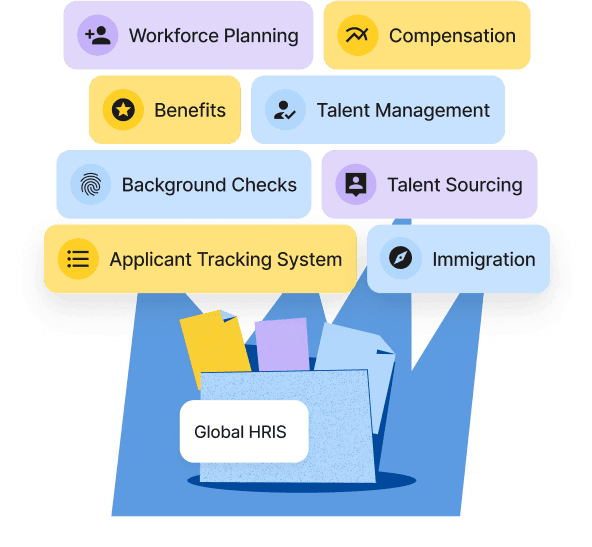Article
12 min read
Improve Global Teamwork with Erin Meyer’s Culture Map
Global expansion
Global HR
Worker experience

Author
Jemima Owen-Jones
Last Update
July 22, 2025

Table of Contents
What is the Culture Map—and why does it matter?
High-context vs. low-context communication
Understanding the roots of misunderstanding in global teams
Why global teams miss valuable voices: The story of Su-Jae
What Japan taught Erin about “reading the air”
Feedback lost in translation: The story of Sabine
How direct feedback can trigger fight-or-flight—and what to do instead
Live Q&A with Erin Meyer
Build and manage your global team with Deel
At Deel, our mission is simple: connect the best talent with the best opportunities—no matter where in the world either may be.
With over 6,500 team members working across 119 countries, we don’t just support global teams—we are one. That’s why we hosted a conversation with Erin Meyer, author of The Culture Map and No Rules Rules, to explore how cultural awareness fuels successful collaboration in international teams.
Erin is one of the world’s leading voices on cross-cultural management and global business. Her work, grounded in decades of research and teaching at INSEAD, offers a practical framework for navigating cultural nuance—something we see daily across Deel’s fully distributed workforce.
As companies scale internationally, understanding how to build trust, give feedback, and communicate effectively across cultures isn’t a soft skill. It’s a strategic one.
This webinar brought those insights to the forefront—backed by real stories from Deel team members who live and work around the globe.
In this session, Erin led an interactive discussion. She invited audience participation via live chat, paused throughout to answer questions from Deel’s Director of People Success, Alice Birks, and engaged directly with Deel team members working from different regions.
From start to finish, the session was designed not just to inform, but to spark reflection and real-time dialogue.
I was raised in a very monocultural place in the Midwest of the US… and it was only as an adult that I started moving to other countries—Southeast Asia, Southern Africa, and then Paris, where I’ve lived for 25 years.
—Erin Meyer,
Author of The Culture Map
What is the Culture Map—and why does it matter?
The Culture Map is a framework developed by Erin Meyer to help global teams work better together. It breaks culture into eight behavioral scales—such as how people give feedback, make decisions, and build trust—and maps countries along these spectrums based on data from over 180,000 interviews across 64 countries.
But this isn’t about boxing people into stereotypes. The real insight comes not from a country’s position on a single scale, but from how its culture relates to another.
For example, Brazilian professionals may see Spanish colleagues as more blunt with criticism. However, from the Spanish perspective, Brazilian feedback might seem too cautious. Neither is “right”—the map simply reveals relative differences. This relativity explains why one culture can be perceived in opposite ways depending on who’s observing.
Erin shared a story: British team members viewed their French colleagues as disorganized. Indian teammates, on the other hand, saw the same French team as rigid. The takeaway? France falls between the UK and India on the time-orientation scale, so both views make sense, depending on the observer’s reference point.
The Culture Map helps global teams avoid two traps:
- Stereotyping individuals based on nationality
- Assuming personal friction is always personal, when it may be cultural
Used thoughtfully, the map helps professionals decode unfamiliar reactions, avoid missteps, and adapt their communication to be more effective, respectful, and strategic. It’s a tool for clarity, not judgment—especially useful when you’re unsure whether a puzzling moment is due to someone’s personality or something deeper, like cultural norms.
You can access the Country Mapping Tool here.
The whole premise of a culture map is that it doesn’t matter where the country falls on the scale. The only thing that matters is the gap between the countries.
—Erin Meyer,
Author of The Culture Map
High-context vs. low-context communication
The webinar turns to the first cultural dimension: high-context vs. low-context communication.
In this chapter of Erin’s book, Erin explains why people from different cultures may experience misunderstandings, even when they speak the same language.
What is low-context communication?
In low-context cultures—like the United States, Germany, or Australia—people do not assume shared knowledge. Clarity is prioritized. You’re expected to “say what you mean.” Presentations follow the formula: Tell them what you’re going to say, say it, then tell them what you said.
Example: If someone from a low-context culture wants you to understand “blue,” they’ll just say blue—no guessing required.
What is high-context communication?
In high-context cultures—like Brazil, India, or Korea—people assume shared context. Meaning often lies between the lines. Words, tone, timing, and silence carry implicit meaning. Communication here is more about interpretation than clarity.
Examples from Deel team members:
- Paula (Brazil) explained the Portuguese word subentendido—a message implied but not said outright. It’s up to the listener to “read between the lines.” Erin summarized it as: “Don’t listen to what I said. Listen to what I meant.”
- Zubair (India) shared that the Hindi word kal can mean either yesterday or tomorrow. The meaning depends entirely on context—an example of high-context language in action. Hindi, like many South Asian languages, often requires the listener to infer meaning from how something is said, not just what is said
- Sarah (Korea) described the Korean term nun-chi, which refers to one’s ability to pick up on social cues. If someone lacks this awareness, they’re said to have nun-chi opda. This idea—that good communication means intuitively understanding what’s not said—is central in many East Asian cultures
Why this matters in global teams
Understanding where team members fall on this spectrum can prevent confusion and friction. For example:
- A US manager might think a Brazilian colleague is being vague
- A Korean employee might find a German colleague’s emails unnecessarily blunt
- A South Asian teammate might wait for unspoken approval, while their American counterpart waits for direct feedback
In global teams like Deel’s, awareness of this dynamic can dramatically improve collaboration.
HR Plugins
Understanding the roots of misunderstanding in global teams
In the next part of the session, Erin frames two essential questions to help participants unpack why global teams often struggle with communication:
- How does a culture’s history impact whether it is high or low context?
- What does this reveal about where misunderstandings most often occur on global teams?
She explains how low-context individuals often feel high-context colleagues are withholding or opaque, while high-context individuals may view low-context communication as overly explicit or condescending.
To explore why these differences exist, Erin compares the US and Japan—two cultural extremes on the context scale.
- Japan, with its long-standing, homogeneous society, developed shared meaning through deep familiarity—people “read the air” without saying much
- The US, by contrast, is young, multicultural, and built on diversity. Americans had to rely on explicit, direct communication to be understood across linguistic and cultural differences—often repeating themselves and writing things down
This leads to her next critical question:
Where do the biggest misunderstandings happen—between two low-context cultures, two high-context cultures, or one of each?
While many of the webinar attendees guessed the second option (one low, one high), Erin shares that the most confusion often occurs between two high-context cultures that don’t share linguistic, historical, or religious roots, like Kenyans and Chinese. Each side “reads the air,” but they’re reading different air. Both sides think the meeting went well—until nothing happens as expected.
Key learnings:
High-context communication only works when everyone shares the same context. In global teams, this rarely happens. So teams must intentionally introduce low-context processes—clarity, repetition, written summaries—to prevent costly misunderstandings.
She closes by encouraging a dual strategy:
- Be a low-context communicator: repeat key points, write things down, confirm understanding
- Be a high-context listener: watch for indirect cues, ask clarifying questions, and don’t assume transparency means trust or competence
This shift supports inclusive, accurate communication across diverse global teams.
Deel Engage
Why global teams miss valuable voices: The story of Su-Jae
Erin gave a real-world example to understand how cultural expectations can unintentionally shut down contributions.
Su-Jae, a Korean professional in Seoul, had just joined a London-headquartered company. He was invited to attend his first in-person meeting at headquarters—a casual team discussion.
Wanting to make a good impression, Su-Jae prepared extensively on the long flight to the UK. But when the meeting began, he said nothing. He simply listened. At the end, he thanked the team for the invitation and left.
Later, he overheard a colleague say to another, “Su-Jae came all this way and had little to add.”
To his UK colleagues, Su-Jae’s silence meant disinterest or lack of preparation. But in fact, it was the opposite. Su-Jae had been taught that listening carefully before speaking is a sign of respect. He was waiting for an appropriate opening—a natural pause—to contribute. But that moment never came.
Here’s why:
Different cultures interpret silence and conversational timing in radically different ways:
- In East Asian cultures like Korea, silence often signals thoughtfulness. A pause between speakers is expected and respectful. It’s not unusual for five or even seven seconds to pass before someone speaks
- In Anglo-Saxon cultures like the UK, silence of more than two seconds can create discomfort. People may interpret it as confusion or conflict, and rush to fill the gap
- In Latin cultures, overlap and interruptions are often seen as signs of engagement and enthusiasm
When all three cultural styles are present in the same room, the quietest group—like Su-Jae’s—is often left out.
This isn’t a matter of confidence or ability. It’s a structural issue: how we expect conversations to flow. Without awareness, global teams may unintentionally reward speed and volume over thoughtful input.
Key learning: Cultural habits around silence and turn-taking shape who gets heard. And without intervention, valuable voices may stay silent.
To fix this, leaders and teammates should:
- Actively invite quieter colleagues to share
- Pause longer before responding
- Refrain from speaking a fourth time if you’ve already spoken three
- Normalize hand-raising or other cues to enter the conversation
Small changes like these can shift participation dynamics and unlock perspectives your team is otherwise missing.
To illustrate this point further, Erin shared another personal story about cultural differences and the importance of cultural awareness.
What Japan taught Erin about “reading the air”
Next, Erin shares a personal story from her book tour highlighting how cultural awareness can shape more effective communication, especially in high-context cultures like Japan.
After releasing The Culture Map, Erin toured several countries, including the US, Brazil, France, and Germany. In each of those places, when she finished her talk and asked for questions, hands immediately shot up. But in Tokyo, she was met with silence. No questions. Erin admitted she wasn’t surprised, but she was disappointed.
Her Japanese colleague Tomoko stepped in. Sensing that people did have questions, Tomoko asked the group again—but in a way that modeled high-context behavior. She scanned the room silently, made eye contact with one attendee, and gently asked, “Do you have a question?” The attendee, previously motionless, immediately engaged. Tomoko repeated this twice more, with the same results.
Curious, Erin asked Tomoko how she knew who had questions. Tomoko explained that in Japan, people don’t make as much direct eye contact as in the West. So in that setting, making and holding eye contact was a subtle signal of engagement—a way to “read the air.”
The next day, Erin tried it herself. She paused after her talk, scanned the room, and noticed one woman meeting her gaze directly. Erin gestured subtly, and the woman responded with a thoughtful question. That moment shifted Erin’s approach.
In her multicultural classroom at INSEAD, Erin realized she had been missing these signals from students of many cultures, not just Japanese. Her experience in Japan reinforced the value of learning how to observe and decode different, often nonverbal, signs of engagement.
Erin concluded this part of the webinar by emphasizing an inclusive, respectful approach to cultural inquiry: don’t stereotype or assume. Instead, ask open-ended questions based on real experiences. Say, “Can you help me understand if that was cultural or personal?” That humility and curiosity are what help global teams become more effective at reading the air—together.
Deel HR
Feedback lost in translation: The story of Sabine
Next, Erin invited participants to analyze a real-life misunderstanding between a French employee and her American manager. This scenario set the stage for exploring cultural differences using Erin’s eight-dimension model.
Erin introduces Sabine, a French client who had just moved to Chicago for work. Before her relocation, Sabine was enthusiastic. But four months in, her American manager, Jim, tells Erin things aren’t going well. He had given Sabine clear feedback but saw no change and worried the assignment might fail.
Then Erin called Sabine. Sabine said things were going great, and her performance review with Jim had been the best of her career.
Clearly, something got lost in translation.
Erin asked the webinar participants to reflect on what caused the misunderstanding. Which cultural dimension was at play? Was it about trust? Authority? Feedback?
Spoiler: it was feedback.
Erin later explains that Jim followed a US norm—three positives for every negative. He began by highlighting Sabine’s strengths before raising concerns. But Sabine, coming from a culture where positive feedback is rare and criticism is direct, missed the message entirely. She tuned out before Jim got to the real point.
In the next section, Erin examines cross-cultural feedback and criticism and shows how to prevent similar issues in your own interactions.
How direct feedback can trigger fight-or-flight—and what to do instead
Erin introduced the second key cultural dimension: how we give criticism. Many confuse this with high vs. low-context communication, but they differ. A culture can be high-context and still give very direct feedback, or low-context and still soften criticism. Understanding that distinction is critical for effective global teamwork.
Example: British vs. Dutch feedback styles: Same language, different impact
Erin shared an example of a British–Dutch team where misaligned feedback styles led to damaged trust. When the Dutch colleague gave blunt, detailed criticism, the British colleague felt attacked. When the British colleague later gave softened feedback to the Dutch teammate, it came across as dishonest and unhelpful. Neither style was wrong—they were just mismatched. Both individuals walked away, unwilling to work with the other again.
Example: US vs. French education: Praise, or precision?
She also described her sons’ experiences in their US and French schools. In the US, teachers anchored negative feedback with multiple positives (“You’re almost there!”). In France, teachers were blunt (“skill not acquired”).
Erin, raised in the US, felt the French style was too harsh until she realized her children, immersed in that system, weren’t demoralized at all. She was the one experiencing culture shock.
Why feedback can feel like a threat
Why do feedback styles matter so much? Because criticism can activate the amygdala, the brain’s alarm system. While the frontal cortex prefers clear, actionable input, the amygdala is tuned to social safety. If feedback feels too harsh or unexpected, it can trigger fight-or-flight. This causes the recipient to either reject the feedback or avoid the giver entirely.
Key learnings:
- Don’t confuse directness with clarity. Be explicit in instructions but cautious in criticism
- Adapt your style by culture. For global teams, default to low-context communication but soften your tone when giving criticism
- Watch for upgraders vs. downgraders. Phrases like “completely wrong” escalate. Try “you might consider…” instead
- Mind the brain. Feedback that bypasses emotional resistance leads to better outcomes
Bottom line: When in doubt, say what you mean—just say it gently.
To close the session, Erin answered audience questions live. Below is a recap of the questions and her distilled responses. Erin’s original wording has been preserved, but we’ve shortened each response to its core message for clarity.
Live Q&A with Erin Meyer
After finishing your culture map research and writing the book, what’s the learning you’ve had post-book that impacted you the most?
We have to be more relationship-oriented while working at a distance. In many cultures, trust is built through emotional connection. Leaders should model deeper check-ins—when someone says “I’m fine,” ask again: “No really, how are you?” This builds trust virtually.
I’ve noticed American managers often call out individuals for praise in front of the group. This doesn’t happen much in Germany. Should others worry if they’re not called out?
No—this isn’t a hidden message that your manager is unhappy. It reflects the US education system, where individual praise is common. However, in multicultural teams, praise or criticism is best given one-on-one to avoid confusion.
You mentioned that multicultural teams need more low-context communication. Should we also be more direct overall when working internationally?
The more international the work, the more we want to be low-context, soft with feedback, and allow more silence to bring in diverse voices. Be yourself, but be aware. Adjust if something doesn’t land well. Awareness is the key.
I’m from Spain and noticed Americans get right to the point in presentations. We usually build context first. Is that a cultural difference?
Yes, this is a difference between applications-first cultures (like the US) and principles-first cultures (like Spain). In Spain, it’s about building an argument and then concluding. In the US, it’s “get to the point and stick to the point.” Tailor your presentation style to your audience.
How do cultural differences in communication show up in remote environments like Zoom and Slack? And how can remote workers bridge those gaps?
Use tools like chat to create equal participation. Ask quieter team members directly if they’d like to contribute. “Bright eyes” in virtual settings can be seen through body language—leaning in, unmuting, looking at the camera. Avoid virtual backgrounds; show your real environment to build connection.

Build and manage your global team with Deel
We hope this recap inspires you to explore more of Erin Meyer’s insights—her teachings have been invaluable to us at Deel.
If you’re looking for better ways to grow and manage your global team, look no further than Deel — a global people platform designed to help you hire, pay, and manage talent across 150+ countries.
With Deel, you get:
- Streamlined international hiring and onboarding
- Deel HR to manage your global workforce seamlessly, regardless of location or worker type
- Tools for learning, performance, and career growth
- Powerful Slack plugins to reduce context-switching and boost connection, including PTO tracking, kudos, referrals, org charts, and more
Book a demo today to see how Deel can simplify managing your global workforce.
More resources

Jemima is a nomadic writer, journalist, and digital marketer with a decade of experience crafting compelling B2B content for a global audience. She is a strong advocate for equal opportunities and is dedicated to shaping the future of work. At Deel, she specializes in thought-leadership content covering global mobility, cross-border compliance, and workplace culture topics.

















